
I was happy to wake up one morning and see a thick mist rolling across the landscape. This isn’t rare here but it is rare to have it happen on a day off when I have time to run out and play in it. That’s why you see so few misty blog posts here. I quickly got myself together and off I went, into the mist.

At first being in such heavy mist seemed a bit like trying to breathe under water and I wondered if my weakened lungs would stand for it, but as usual seeing the beauty of the forest took me away to that magical place where there are no cares, and I quickly forgot about breathing issues. If, when you come out of the forest, you immediately give attention to your time spent there, you find that there were no problems to solve while you were there, no yesterdays or tomorrows to worry about, only the joy of what was happening right then and there. Nothing else existed for you. This is why, I believe, people seek out wild places, and this is why people like Jane Goodall say things like “It was in the forest that I found the peace that passeth all understanding.”

And the beeches might have seemed more beautiful than you had ever imagined they could be. How could you have missed such beauty, such serenity, and such sheer joy for so long, you might wonder. Don’t wonder; just be thankful that you have found what you have, because now, as John Muir said: “Nature’s peace will flow into you as sunshine flows into trees. The winds will blow their own freshness into you, and the storms their energy, while cares will drop off like autumn leaves.”

The sun kept trying to break through the mist and I kept trying to get a shot of it happening, but neither of us had much success.

What I believe was a crust fungus called Phlebia radiata, or wrinkled crust fungus, had formed a cup and it was holding water. In fact the mist was so thick on this day that everything was wet and dripping.

I admired the perfectly round holes an insect had made in a pine tree, which was now a log. I once knew what made these pencil size holes but I have forgotten, and it really doesn’t matter anyhow. At least to me it doesn’t matter. It might matter quite a lot to the forestry students at Yale University who come out here to practice their craft.

Wood ear fungi (Auricularia auricula-judae) listened to the silence. This “winter mushroom” is usually found on fallen branches in winter and early spring. It’s one of the jelly fungi and it feels just like your earlobe. They can have some color but these examples were fairly pale. My color finding software sees “peach puff.”

I saw that the mist seemed far off now. It wasn’t as close or as thick as when I had started.

And over there bright sunshine was falling on the beaver swamp. It was luminous, and it reminded me of the luminists; those American painters who tried to capture the quality of light.

Here is a fine example of a luminist painting. It was painted in 1875 by by Frederic Edwin Church, who called it “Autumn.” Luminism shared an interest in the quality of light with impressionism but that was about all they shared. There were a lot of technical differences like the quality of brush strokes between them, but I won’t go into all of that. Luminism lasted from about 1850 to 1870, and was concerned not only with light, but mood as well. Luminist paintings are calm and tranquil, with soft hazy skies and reflections in the water, just like what I found here in Yale Forest.

But here in Yale Forest all thoughts of Luminism quickly evaporated because the sun had won out and the misty atmosphere had left the place. I supposed I’d have to turn to the impressionists for the rest of my walk. It really is amazing how fast mist can disappear. I’ve raced up hillsides hoping to get shots of mist in the valley below, only to find no mist and the sun shining brightly when I reached the summit.

I found quite a few partridge berries (Mitchella repens) that the turkeys had missed at the the base of a tree. They are interesting so they’re worth a closer look.

What is amazing about these small berries is how a single berry originates from two flowers. The ovaries of the two flowers join and form one berry that contains 8 seeds, and the two dimples found on the berries tell the story of where the flowers once were. Partridgeberry is one of the lowest growing evergreen plants on the forest floor, hardly growing more than 3 or 4 inches high.

I saw a fungal garden growing on the end of a log.

And I saw some more pixie cup lichens forming. Isn’t it funny how you can go all of your life without seeing something but then when you finally do see it, you start seeing it everywhere?

There are still lots of fallen trees out here. The wind has really ravaged the place over the last couple of years, it seems.

But there was little wind on this day. It was still early in the morning and it was a beautiful day to be outside. I wasn’t too far from the beaver pond when I took this photo.

You have to cross what was a small stream to get to the beaver pond. It has gotten wider over the years so what I was once able to step over I now have to jump over. I’m always a little wary of jumping when I’m off in the woods alone but I came back unscathed. I’d rather jump than try to walk across on slippery rocks. I have a friend who tried that and ended up nursing cracked ribs for a few months.

I saw that someone had pulled the beaver dam apart again. This might seem cruel to some but it is neccessary when beavers build dams too near human structures. There is a busy road near here that has nearly flooded due to beaver dams, so the highway department keeps a close eye on them.

I’ve taken beaver dams apart and taking apart even a small one like this is hard work. They use stones, mud and branches to weave a very strong dam. It would easily take two men all afternoon just to do what we see here.

The stone wall going down into the beaver pond says two things; that this was once farmland and that the beavers came along after the wall was built.

The beaver pond drains off into the woods and the woods are turning into a swamp. Along this stream is where I come in spring to find the beautiful woodland horsetail (Equisetum sylvaticum.)

I also come out here to see hundreds of goldthread plants (Coptis groenlandicum) in bloom in spring. Their shiny evergreen leaves make them easy to find at any time of year.

A cinnamon fern hung on to one last leaf.

But I’m sure it must be part of this pile by now.

As I was leaving I saw an old man, asleep in a pine branch, with a jelly fungus for moustache. I took a couple of quick shots and let him sleep. I hoped his dreams were pleasant ones.
If you see no reason for giving thanks, the fault lies only in yourself. ~Tecumseh, Shawnee
Thanks for coming by. I hope this post helped make your day a little brighter, and I hope everyone will have a safe and happy Thanksgiving.